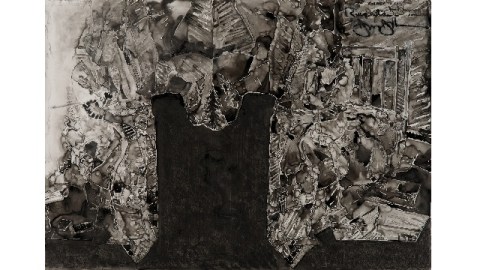Jasper Johns and Art History in the Making

“Regrets, I’ve had a few,” Frank Sinatra warbled in “My Way,” before adding wistfully, “But, then again, too few to mention.” Sinatra sang that song at the end of a long, successful career as a titan turning back and surveying the long road behind him and the shorter one ahead. A similar kind of retrospection turns the Museum of Modern Art in New York City’s new exhibition Jasper Johns: Regrets, which runs through September 1, 2014, into a survey of art history in the making. Not only is the show about canonical artist Jasper Johns’ latest additions to art history, but also about the history of making art, of taking different raw materials and media and entering the process of creating art. For a relatively small show on a tightly targeted subject, Jasper Johns: Regrets hits the mark beautifully and raises a triumphant flag signaling that art and art history aren’t dead just yet.
Some might be surprised that Johns is still alive. Anyone who cracked open an art history textbook in college will probably remember the now 60-year-old, encausticflag paintings of the now 83-year-old icon. Or maybe you remember his encaustic Target with Four Faces? Or perhaps Johns’ mash-up of the numbers 0 through 9 comes to mind? Those greatest hits played on more than half a century ago, but Johns has continued to make art ever since, delving into different media as well as venturing into collaborations with dancer Merce Cunningham and other artists, always looking for new means of expression. Johns even played himself in a 1999 episode of The Simpsons titled “Mom and Pop Art.” In one especially memorable sculpture from 2009, Johns took a letter from Vincent van Gogh to his friend and fellow artist Émile Bernard, reproduced part of the letter onto one side of a wax relief using block type, spelled out the same words in American Sign Language on the opposite side, and called the result Fragment of a Letter.
As shown by works such as Fragment of a Letter, Johns’ art history consciousness—of his own role as well as that of others—plays a big part in the current content of his art. While reading an art auction catalogue in June 2012, Johns saw a photograph taken by John Deakin around 1964 of artist Lucian Freud, who had passed away the year before. The painter Francis Bacon often commissioned Deakin to take photographs of selected subjects for Bacon to later use while painting. The photograph in the catalogue was found in Bacon’s studio after his death in 1992 and showed signs of use—creases, paint stains, tears, and marks from where a paper clip once held it in place for reference during painting. In the photograph, Freud sits on a bed with his right hand dramatically clasped to his forehead in what could signify exhaustion, frustration, despair, or all of the above. Bacon used that photograph and others to paint Three Studies of Lucian Freud is a 1969, which sold for $142.4 million USD in November 2013, making it the most expensive (in non–inflation-adjusted dollars) auctioned painting ever.
All those associations with artists and art history linked by that single image inspired Johns to create a collage using a photocopy of the photograph on which he added acrylic, watercolor, colored pencil, and ink. The resulting diptych image featured on the left a black and white Freud surrounded by a colored bedroom, whereas the right-hand image turned Freud into a Technicolor dream exploding with bold yellows, blues, greens, and reds. To “sign” the collage, Johns used a signature stamp he had made to decline invitations to the endless event organizers clamoring for his iconic presence. The stamp printed a simple, curt, “Regrets, Jasper Johns.” Thus, the title for the series and the exhibition was born.
Over the next year and a half, Johns made about 30 works—just two paintings, but many drawings and prints—all spawned from that initial burst of inspiration. In addition to that initial collage (now titled Study for Regrets), Johns painted Regrets as a watercolor with charcoal and pastel on paper before yet another work titled Regrets as an oil on canvas. Still wrestling creatively with the idea, Johns moved over to a series of untitled pieces in which he applied ink directly to plastic (one example shown above). At the same time, the diptych of Freud’s figure became a doubled mirror image, with Freud’s figure becoming increasingly abstract. There’s a wonderful abstract, flowing quality to these ink on plastic images, as if the image were moving and still at the same time. Johns then arrests that flowing quality by moving on to a series of aquatints on Hahnemule copperplate paper, taking one image through twelve states and another through five. In an early drawing of the Regrets series, Johns jotted down the words “Goya? Bats? Dreams?”, probably alluding to Francisco Goya’s 1799 aquatint The Sleep of Reason Produces Monsters, a classic image of despair. Even at the earliest, sketchiest stages of exploration, Johns’ art consciousness connected to Goya’ precedent both in terms of content and medium.
Such transparency of process makes Jasper Johns: Regrets a truly fascinating show. It’s as if a master magician decided to reveal all his tricks as a final curtain call. Apparently, Johns approached the MoMA with the idea of showcasing these latest works, an offer they couldn’t possibly refuse. In an age of biennials full of overintellectualized art deemphasizing technique and hands-on media mastery, Johns goes old school and shows the youngsters how it’s done. A strange, seemingly unrelated inclusion in the show is a series of monotypes that resurrects Johns’ 0-9 number series from decades before. Is Johns counting down his lasting days? Is he reminding us of his greatest hits in the middle of these new works? Or is he saying that every new exploration involves a return to the beginning, to the absolute zero of one’s career and the roots of art history and the materials ever present beneath the clutter of criticism and acclaim? Johns might be saying all of these things or none of them, but at least he’s making us look closely and listen for messages again.
Does Jasper Johns have regrets of his own? In alluding by several removes to Bacon’s auction blockbuster, is Johns lamenting the current state of the art world’s hyperactive price inflation? I’m guessing that Johns, like anyone who’s lived a long life, has his regrets. Yet, like Sinatra’s, those regrets are probably too few to mention. Instead, Jasper Johns: Regrets will leave you regretting getting caught up in the current misadventures of the art world at the expense of looking back and getting back to the fundamentals. If this is Jasper Johns’ swan song, his final statement on what it was and is to be artist, as well as a primer on the promise of becoming a true artist, then he leaves the stage of art history with no regrets.
[Image:Jasper Johns (American, born 1930). Untitled. 2013. Ink on plastic. 27 1/2 × 36″ (69.9 × 91.4 cm). The Museum of Modern Art, New York. Promised gift from a private collection. Art © Jasper Johns/Licensed by VAGA, New York, NY. Photograph: Jerry Thompson.]
[Many thanks to the Museum of Modern Art in New York City for providing me with the image above and other press materials related to the exhibition Jasper Johns: Regrets, which runs through September 1, 2014.]




